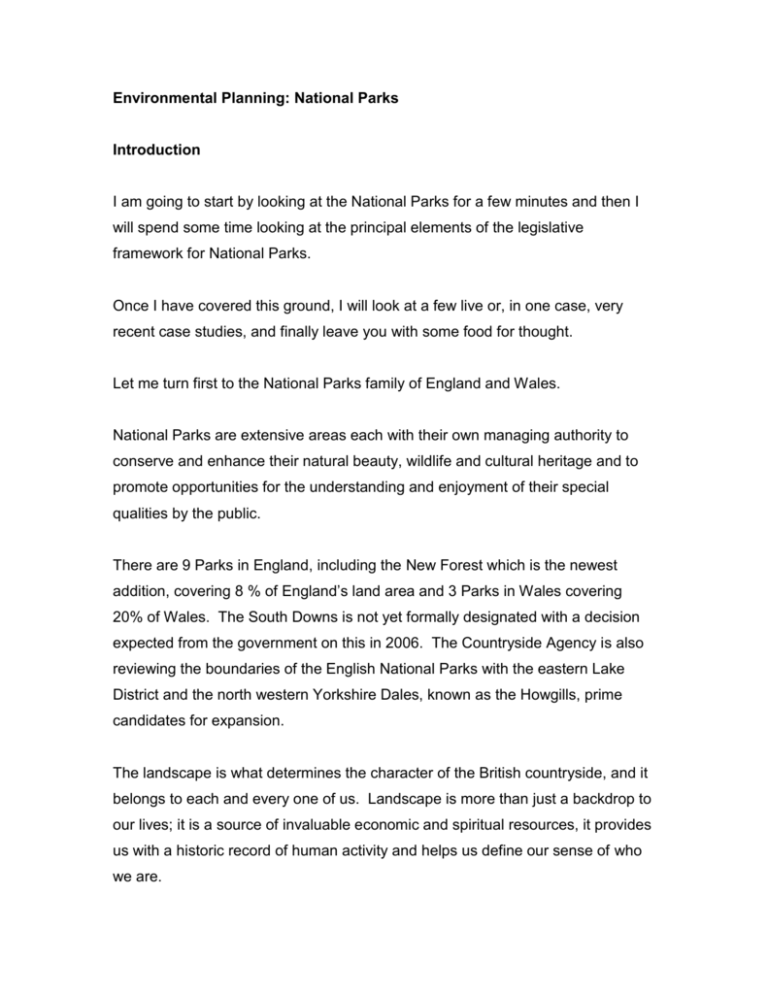Environmental Planning: National Parks
advertisement

Environmental Planning: National Parks Introduction I am going to start by looking at the National Parks for a few minutes and then I will spend some time looking at the principal elements of the legislative framework for National Parks. Once I have covered this ground, I will look at a few live or, in one case, very recent case studies, and finally leave you with some food for thought. Let me turn first to the National Parks family of England and Wales. National Parks are extensive areas each with their own managing authority to conserve and enhance their natural beauty, wildlife and cultural heritage and to promote opportunities for the understanding and enjoyment of their special qualities by the public. There are 9 Parks in England, including the New Forest which is the newest addition, covering 8 % of England’s land area and 3 Parks in Wales covering 20% of Wales. The South Downs is not yet formally designated with a decision expected from the government on this in 2006. The Countryside Agency is also reviewing the boundaries of the English National Parks with the eastern Lake District and the north western Yorkshire Dales, known as the Howgills, prime candidates for expansion. The landscape is what determines the character of the British countryside, and it belongs to each and every one of us. Landscape is more than just a backdrop to our lives; it is a source of invaluable economic and spiritual resources, it provides us with a historic record of human activity and helps us define our sense of who we are. Landscape character is defined as 'a distinct, recognisable and consistent pattern of elements in the landscape that makes one landscape different from another, rather than better or worse'. Essentially, landscape character is that which makes an area unique. There is a mix of landscapes across the Parks. For example, the dramatic gritstone edges and heather moorland of the Dark Peak, the steep, wooded inland valleys of Exmoor with villages and farmsteads nestling in the sheltered valley bottoms and the rugged peaks of Snowdonia. But the National Parks are not just important environmentally, they are of crucial importance to the economy, both directly though visitor spend or indirectly, for example through branding and promotion of local produce. And of the course the Parks are enjoyed by millions of people each year with the Peak District the second most visited National Park in the world after Mount Fuji in Japan. The Parks are especially valued for their peace and beauty – 58% of visitors come for the scenery and landscape, 29% for the peace and quiet. Enjoyment by millions is all well and good but it’s vital that all sections of society have the opportunity to experience and appreciate the Parks. This is important for both the communities concerned and also for the Parks themselves, as if the Parks are to continue to be relevant to modern society for another 50 years they need to reach and involve all sections of society. This image is one of many visits inspired by a CNP project called Mosaic, which aimed to build stronger links between ethnic minority communities and National Parks. Visitors to our Parks from overseas often raise an eyebrow or two when they discover that thousands of people live or work in our Parks, and that in some cases the Parks contain towns, roads, or even power stations and factories. They may be more used to the wildlife reserves of southern Africa or the wildernesses of north America where communities have often been excluded. This is in stark contrast to our Parks which are lived-in, worked-in landscapes that have been shaped by the hand of human influence for hundreds of years and which need continued human management in order to achieve conservation and indeed enhancement. But where people live they need to earn a livelihood. And where people live and work they need schools, hospitals and other facilities, which can sometimes present challenges to the land use planning system in terms of accommodating development, controlling natural resource use and providing more affordable housing. Since they were established during the 1950s National Parks have been putting sustainable development into practice, long before the term came into use. National Parks are viewed by the Government as role models for sustainable management of the wider countryside. Their pioneering work has been recognised by DEFRA and the Welsh Assembly Government, which grant a Sustainable Development Fund to each Park Authority in order to further good practice, and see National Parks as being test-beds for rural revival. National Parks are increasingly innovative in finding solutions to the socioeconomic challenges that rural communities face, and this is undoubtedly assisted by the strong planning powers which National Park Authorities have. Rather than stifling development, the statistics show that their average approval rate for planning applications is 89% which compares favourably with national approval rates. Research for the Office of the Deputy Prime Minister found that approval rates for farm diversification was slightly higher in National Parks than in other local planning authorities. The Council for National Parks I would now like to move on and tell you a little about the Council for National Parks. We are a charity and were established in 1936, initially to campaign for the designation of National Parks which was achieved in the post-World War II era of nationwide reconstruction. The Parks were established by the same government which created the National Health Service. We are an umbrella for over 40 different conservation and amenity voluntary organisations, including the National Trust, the Wildlife Trusts and user groups such as the Ramblers’ Association and Cyclists’ Touring Club. We engage in a range of activities, including raising awareness of the Parks and undertaking research, but protecting the Parks using policy and legislation is at the core of our work. We couldn’t do this without a variety of formidable partnerships including with the National Park Authorities (the bodies charged with the delivery of National Park purposes), companies (as the corporate sector can play both the role of friend and foe to the parks so constructive engagement with companies is an essential part of our work) and government. And we are helped in our partnerships by household names like actor Brian Blessed, our President, and journalist Libby Purves. The legislative basis for National Parks The legislative basis for National Parks is set out in the 1949 National Parks and Access to the Countryside Act, which enabled the designation of most of the Parks in the 1950s. The purposes of National Parks were quite simply preserving natural beauty and promoting public enjoyment. The Broads however has a different legislative basis emanating from the1988 Norfolk and Suffolk Broads Act but it is widely regarded as a member of the National Park family and enjoys the same level of protection as the other Parks. The Broads has an additional third purpose to protect the interests of navigation which as anyone who has visited the area knows is no mean feat. The Sandford Principle was first conceived in the 1970s but not enacted until the 1990s and exists to provide legislative priority for the first purpose in cases of irreconcilable conflict. The references are on the slide. In our experience the principle is rarely invoked because every effort is made to resolve potential conflicts through negotiation or management and, in any case, most conflicts are within the second purpose itself (between different recreational uses) or between conservation and economic development, in which case, unlike the position in Scotland, Sandford does not bite. The 1995 Environment Act established free-standing National Park Authorities, enshrined the Sandford Principle in law for the first time and revised the purposes. It also introduced a duty on relevant authorities, which includes public bodies and government departments, to have regard to Park purposes in their decision making or when carrying out their functions. It also introduced a duty that in pursuing their statutory purposes, National Park Authorities shall seek to foster social and economic well-being of their local communities. The government considers that this should be done in cooperation with other bodies, and, presently at least, without incurring significant expenditure. National Parks and the planning system A National Park Authority is the sole local planning authority for its area and in terms of the Planning and Compulsory Purchase Act 2004, Authorities in England are classified as former strategic planning authorities. National Park Authorities are in the process of preparing Park-wide Local Development Frameworks and there is much activity this summer on the new Statements of Community Involvement. Until the new system is up and running the existing patchwork of Local Plans and joint Structure Plans will continue to make up the development plan for the Park areas. Joint working is encouraged, particularly at the area action plan level. National Park Authorities in England are actively involved in the preparation, monitoring, review and implementation of Regional Spatial Strategy (RSS) policies, with some RSS proposing sub-regional chapters to coincide with Park boundaries. National Park Authorities are responsible for the implementation of the development control function in their area, with the majority utilising an in-house service with ‘extras’, such as technical advice, bought in as and when they are needed. A high % of applications is delegated to officers but generally this is below the ODPM’s desired 90%, not least because of the sensitive environment in which development control decisions are made. There is a higher emphasis in National Parks on pre-application discussion, with the proof of course being in the pudding in terms of high quality development and a high rate of planning approvals. Unsuitable applications are often weeded out at an early stage resulting in greater certainty for both business and the public. Specific guidance exists for assessing major developments with the test being whether or not exceptional circumstances and public interest can be demonstrated. This includes an assessment of national need, alternatives and environmental impacts. Environmental policy case studies I would now like to look at three case studies: Ribblehead (a former quarry in the Yorkshire Dales); Bluestone (a proposed holiday village in the Pembrokeshire Coast); and Whinash (a proposed wind energy development on the doorstep of the Lake District and the Yorkshire Dales). Ribblehead is a former quarry which covers 24 hectares and is of national importance for wildlife and cultural heritage. It is also located wholly within the Yorkshire Dales National Park. In 1999, Hanson decided not to oppose a Prohibition Order at this site, which meant that the threat of this site being worked would disappear as the old mineral permission would be extinguished. This is an inspiring example of a voluntary-corporate-statutory partnership, which resulted in positive gains for both wildlife and landscape and helped catalyse the relinquishment of several other old mineral permissions in the National Parks. This important initiative by the aggregates industry was very welcome and sets a positive agenda for other sectors to follow. Some of you may be familiar with the Bluestone case as it has had a reasonably high profile in the planning and legal press. Firstly some facts. Bluestone is a major holiday village proposed in the Pembrokeshire Coast, comprising several elements including 340 log cabins, a new village and a sewage treatment works. Despite being held to be contrary to the development plan it was approved by the National Park Authority, following a hard sell by the developer in terms of local jobs. Pembrokeshire falls within an Objective 1 area which was part of the backdrop to the decision. Interestingly, the latest unemployment figures for the area are at an all time low. Press reports of local tourism industry managers lamenting the local labour shortage and describing their overseas recruitment efforts for workers, for instance in eastern Europe, reinforce our view that the claim of jobs should not have been sufficient to override the development plan. Despite the controversy surrounding the application the Welsh Assembly Government declined to call in the application because it deemed that only issues of local significance were at stake. This case quickly became a political hot potato, with support expressed in public by ministers of governments in Westminster and Cardiff and in advance of planning consent being obtained. As far as the Council for National Parks was concerned the principles at stake were important enough to trigger our first ever application for judicial review. Jack J heard the case in December and in January, unfortunately, dismissed the claim. We sought and were granted leave to appeal and Keene LJ considered that the case raised important issues for Section 54A and the development plan, as we had argued that the claim of local jobs should not be allowed to override the development plan and its policy on major developments. This was because local jobs had already been taken into account as part of that policy and therefore was immaterial to the decision and not “an other material consideration” capable of displacing the primacy of the plan. To my mind, this case clearly highlights the imbalance within the legal justice system where well-financed organisations have an obvious head start and smaller organisations or members of the public are generally excluded from entering into litigation. Cost is undoubtedly the most significant factor which prevents many environmental cases from being brought forward. There is no doubt that without the outstanding commitment of our legal team (David Wolfe from Matrix and Richard Stein and Jamie Beagent from Leigh Day & Co) we would not have been able to bring the case forward. As it is, the Court of Appeal sat on Friday, and Lord Justices Latham, Jacob and Kay heard the case. We await their judgment on both the substantive matters and also on costs. In conclusion, the general practice that costs follow the event and the high nature of the costs themselves is, to my mind, a serious impediment to accessing the legal justice system in the UK today. Finally a few words on Whinash, another high profile case, where 27 wind turbines each standing at 115m high have been proposed on the doorstep of the Lake District and Yorkshire Dales, and in land that is currently under active consideration for inclusion in the Lake District because of its high landscape quality. The installed capacity of the development would exceed 50MW so it is classed as a power station with a final decision to be made by the Department of Trade and Industry. The public inquiry concluded on Friday. We gave evidence that the scale of this development was inappropriate for this sensitive landscape. While allowing plenty of scope to argue the landscape demerits of the case, a downside of the inquiry is that it has polarised debate on renewables with organisations either falling into ‘pro’ or ‘anti’ camps. This is unfortunate as there should be no choice on whether to develop renewables, the real question should be where. And even more importantly, the vital importance of reducing energy use and achieving more efficient use are all too easily forgotten when wind turbines are on the table for discussion. Finally, I would like to leave you with some food for thought which I hope we may be able to consider in the discussion session. Firstly, given increasing development pressures and our ‘must have now’ lifestyles, are National Park policies and legislation robust enough for 21 st century life? Secondly, given the issues I have highlighted from our experiences during the Bluestone case, how are we to provide the level of access to environmental justice envisaged by the Aarhus Convention without a radical look at the costs system. Thirdly and finally, climate change is an imperative but consensus not conflict will be essential if we are to make the progress we are all desire. Ruth Chambers Council for National Parks Tel 020 7924 4077 ext. 222 Email ruth@cnp.org.uk 19 June 2005









